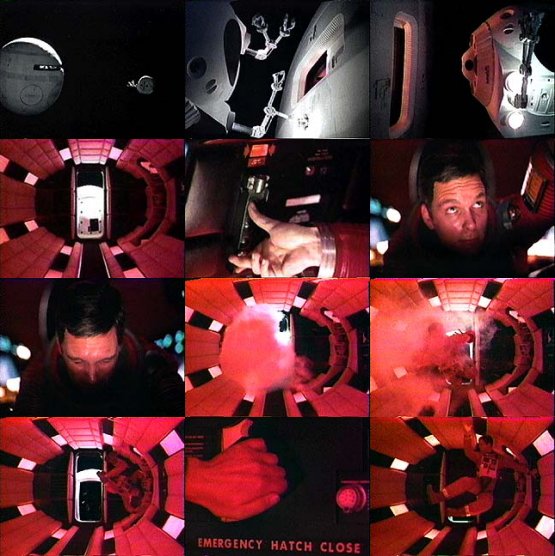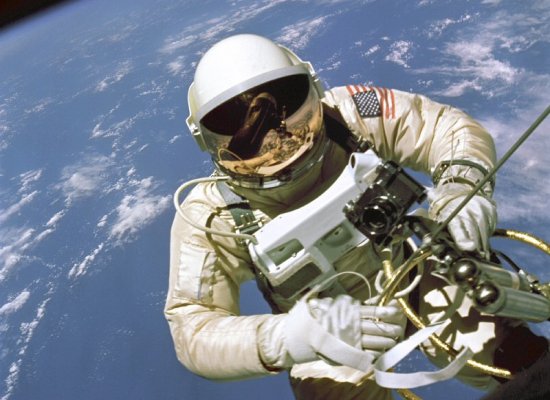|
||||||||||
|
|
||||||||||
|
||||||||||
|
|
||||||||||

The likelihood of this scenario has been debated for years, but most experts agree that it is a pretty good representation of reality. The movie's director Stanley Kubrick and author Arthur C. Clarke strove for accuracy in the depiction of spaceflight and based Bowman's airlock scene on NASA and US Air Force experiments exploring the limits of survivability in low pressure atmospheres. This research, conducted during the 1950s and 1960s, concluded that a human exposed to a vacuum will remain conscious for ten to fifteen seconds and can survive for up to 90 seconds with relatively minor and reversible side effects. The exact limits are unknown, but death is believed to be unavoidable after two to four minutes of exposure. Contrary to depictions in many other popular movies, a person exposed to the vacuum of space does not instantly pass out or freeze to death, the body does not explode, and blood does not boil.
Members of PETA may want to stop reading now, because most of the experimentation to determine these findings was conducted on animals. Chimpanzees and dogs were particularly common subjects used during decompression and recompression tests. Several of these studies determined that a subject experiencing a rapid decompression to a vacuum will retain some level of consciousness for between nine and twelve seconds. Unconsciousness only occurs once the supply of oxygen in the blood is depleted. Furthermore, a human will have no more than five to ten seconds to take any action in response to the decompression. Shortly after losing consciousness, the body will experience paralysis followed by convulsions and finally paralysis again. Water vapor also begins forming in soft tissue causing the body to swell, perhaps to as much as twice its normal volume if not constrained by a suit. Over the next 30 to 60 seconds, heart rate slows, blood pressure drops, and blood circulation stops. Gases and water vapor rapidly escape through the mouth and nose causing these parts of the body to drop to near freezing temperatures. The rest of the body cools more slowly.
Although some animal subjects perished due to fibrillation of the heart within the first minute of exposure, these cases proved the exception and an air-breathing creature will almost always recover if recompression occurs within 90 seconds. Breathing usually begins spontaneously without any need for outside resuscitation. However, resuscitation becomes impossible after heart activity has stopped regardless of recompression time.
The same studies also addressed the damage a body endures when exposed to a rapid decompression. Initial injuries are relatively minor including decompression sickness (also known as "the bends") and some swelling of skin and underlying tissue. These effects begin about ten seconds after exposure but quickly reverse after recompression. Once the body loses consciousness from lack of oxygen, the effects become more severe and begin to accumulate. Temporary neurological damage and blindness were found to be common in animal subjects after longer periods of vacuum exposure, but the effects usually disappear rapidly upon recompression. Researchers concluded that although a subject's condition may appear grave after vacuum exposure, recompression to even as little as 0.25 atmospheres within 60 to 90 seconds will usually allow survival and a complete recovery within a short period of time.

One of the worst things a person can do, however, is to try holding his breath. The difference in pressure this creates will cause the lungs to rupture. This type of injury is almost always fatal. It is also a common concern in scuba diving and divers must learn not to hold their breath while ascending or risk similar lung injury. Eardrum damage is also possible if a person's sinuses are congested. This blockage traps air inside sinus passages and prevents pressures inside and outside the head from equalizing, much like air travelers sometimes suffer. Another possible injury that an astronaut without a spacesuit may experience is severe sunburn of the skin. This injury is not directly related to the fact that space is a vacuum but happens when the astronaut is exposed to the ultraviolet radiation of sunlight without any protective barrier.
Having addressed the injuries a person will likely suffer, it is also worthwhile to explain those a person will not experience. A body or head does not explode, as sometimes shown in movies and television programs, because skin and bones have enough strength to contain the higher pressure fluids within the body and prevent them from escaping outward. Blood does not boil for a similar reason. Human blood pressure is already at a relatively high pressure compared to normal atmospheric conditions. Even if the external pressure drops to a vacuum, blood vessels maintain a high enough pressure that the body's temperature remains below the boiling point of water and prevents blood from boiling. The body will not instantly freeze either because even though space is generally very cold, the fact that it is a vacuum means there is no medium to conduct heat away from the body and it cools rather slowly.
The only parts of the body where these trends do not necessarily hold true are the nose and mouth. As mentioned earlier, the rapid escape of air through these humid regions causes an evaporative cooling effect. Moisture in the mouth absorbs body heat causing the mouth to quickly cool to near freezing temperatures. As saliva absorbs heat, it boils into water vapor and is carried away with the escaping air.
Although the experimentation that generated these findings was conducted primarily on animals because of the inherent danger, there have been a few instances when the limits of human endurance have been tested by exposure to very low atmospheric pressures. In 1965, a person was testing a pressure suit in a vacuum chamber at NASA Johnson Space Center in Texas. The suit began to leak and was accidentally depressurized to a near vacuum. The person lost consciousness in 14 seconds but repressurization of the chamber began within 15 seconds. Consciousness was regained in about 30 seconds with no reported ill effects, and the person later said that his last memory was of the saliva on his tongue starting to boil.
Another brush with low pressure occurred in 1960 when Joe Kittinger made his record-breaking skydive from an altitude of over 100,000 ft (30,480 m). The right hand of Kittinger's suit sprung a leak while he was ascending in a balloon resulting in a painful swelling in his hand. Kittinger later said that his hand had swollen to twice its normal size and was completely useless. Despite the stiffness and loss of circulation, however, Kittinger continued his flight and his hand had returned to normal about three hours after landing back on the ground.

A similar occurrence happened to an astronaut on Space Shuttle flight STS-37 in 1991. A small puncture was torn in the astronaut's glove and also made a small cut between his thumb and forefinger. The astronaut didn't even realize the accident had occurred during his spacewalk, but later noticed a painful swollen spot on his hand. The astronaut's skin and coagulated blood from the cut sealed the hole, and the minor injury quickly healed.
Not all such incidents have been as harmless as these, however. Another vacuum chamber accident at NASA resulted in somewhat longer exposure than the 1965 case described above. After the chamber was decompressed, the victim coughed, lost consciousness, and remained unresponsive over the two to three minutes it took to repressurize the chamber. The person was seen to make a few short gasps once full pressure was regained but did not begin breathing on his own. Physicians began CPR immediately but the victim had suffered heart failure and could not be revived.
A disaster also occurred on the Soviet space mission Soyuz 11 in 1971. The three crewmen departed the first Soviet space station for their return to Earth when a valve in their capsule accidentally opened and began venting its atmosphere into space. The gases leaked out over 30 seconds as one of the crewmen attempted to close the valve manually. Unfortunately, he had only succeeded in closing the valve halfway before succumbing to unconsciousness. The capsule automatically re-entered the atmosphere and landed in Russia. Recovery personnel soon came upon the crew who looked like they were simply asleep and showed no swollen skin or other signs of vacuum exposure. Believing they had only been unconscious for a brief period, personnel attempted CPR but were unable to revive the crew. It is believed they had already been deceased for 15 to 20 minutes by the time the rescue party arrived making any resuscitation impossible. In the wake of the tragedy, the Soyuz capsule was redesigned and its crew have worn pressurized spacesuits ever since.
Although exposure to space is not as gruesome as is often depicted in movies, it is obviously still something to be
avoided. Engineers and scientists at NASA and in Russia work very hard to ensure that decompression accidents do
not occur to protect the safety of those who travel into space. Decompression is also a serious concern for
aircraft, and regulatory agencies require that commercial airliners have cabin
pressurization systems with multiple redundancies.
- answer by Justine Whitman, 28 January 2007
Read More Articles:


|
Aircraft | Design | Ask Us | Shop | Search |

|
|
| About Us | Contact Us | Copyright © 1997- | |||
|
|
|||